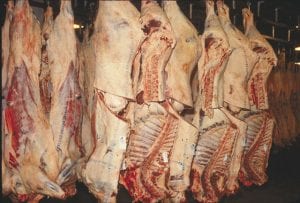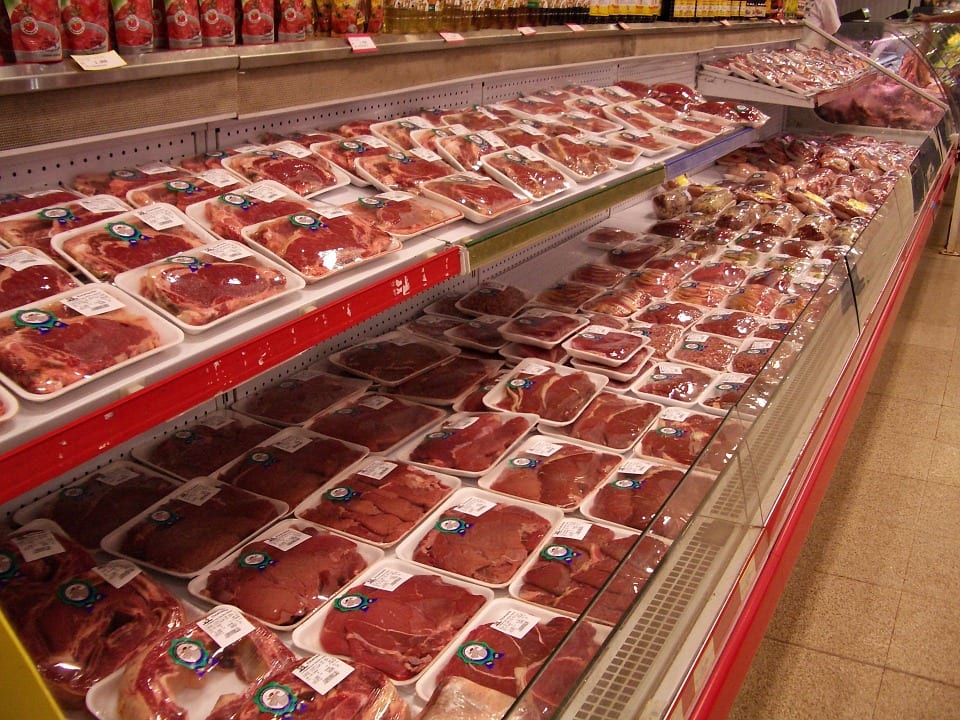The same big meat industry that willingly hires undocumented workers now wants to perform its own meat inspections. What could possibly go wrong?
How much do you trust the meat industry? Are you pro-business enough to trust the industry to police itself, avoiding the need for so many “big government” inspectors to make sure what you serve up is safe enough to eat, and that they routinely engage in ethical labor practices? If so, there’s nothing to worry about. Relax and have some sausage.
The rest of you might be interested to know that major players in the meat industry are working with the USDA to loosen regulations for carcass inspections in slaughterhouses. Why, you may ask, are profit-centered companies willing to take upon themselves the trouble and expense of training their own inspectors? Surely it’s not merely a good-hearted giveback to the hard-working taxpayers of America. If you’re thinking that there must be some payoff for the meat industry, you’d be right.
Current standards allow meat processing facilities to slaughter over a thousand hogs every hour. Why so few, you might ask? They’re limited by the number of USDA inspectors deployed at each plant to take a look and a sniff at the carcasses whizzing by to ensure that they’re wholesome, and not, say, diseased or inappropriately contaminated. Nowadays, there are seven (7) inspectors per facility making sure those 1,106 hogs that pass by each hour receive the thorough, detailed safety inspection you expect before serving your kids some pork chops. (There’s one more veterinary inspector stationed outside to ward off obviously sick animals.) If you think that sounds like barely enough eyes and noses to catch every intestinal fecal splatter, you’re not alone.

The idea, then, is to have some trained employees pre-look and pre-sniff the incoming carcasses before they get to the government inspectors. That way they can cut off the bad parts first, and they won’t need so many USDA inspectors nosing around their facilities. From the point of view of the meat industry, it’s win/win. They can ramp up the number of animals slaughtered and processed, making money on volume. The USDA can save money by employing fewer food safety inspectors, although they claim all meat would still be federally inspected. Who loses? Well, as long as you trust the sort of foxes that lobby for the position of henhouse guard, then everything is fine.
Meat industry giant Tyson is already applying for a waiver allowing them to move to this production model at a beef processing plant in Kansas. Instead of initiating a formal pilot program that allows for the public to comment, the USDA often prefers to grant waivers to individual companies looking to “innovate” changes in the inspection process. The waivers enable the changes to proceed with less scrutiny, or, perhaps from another perspective, meddling.
It’s worth remembering, too, that workers at slaughterhouses and on disassembly lines are being exploited beyond what one might consider reasonable for people who serve as gatekeepers between factory farms and your family’s dinner table. The recent ICE raid on seven poultry processing plants in rural Mississippi netted 680 Latinx workers who were led away in zip ties while their children cried in fear, but conspicuously left unscathed the head honchos who willfully hired and exploited immigrant labor. The meat industry brings in undocumented workers to lower costs through union avoidance, and because the workers are often too intimidated and afraid to report safety violations, illegally low pay, abysmal working conditions, and harassment. Can we really trust them to police themselves in any way?
Related: Prisoners for Profit: Not a Free Market
Sources:
How Many Hogs Can Be Slaughtered Per Hour? Pork Industry Wants More
Why It’s Immigrants Who Pack Your Meat


Join the conversation!